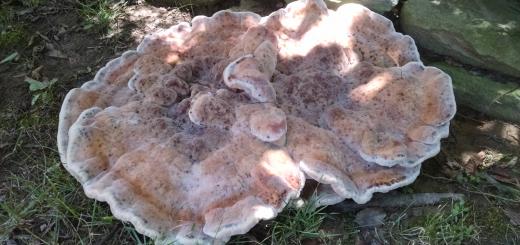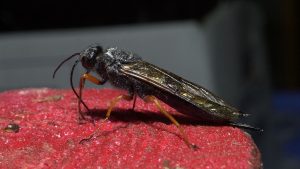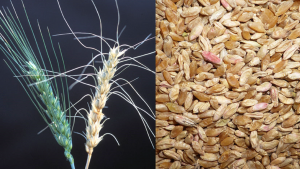#079: Tips on Mushroom Collection
Are you interested in collecting and identifying mushrooms on your own? If so, read this post to learn the basics of mushroom collection! What you will need: notebook, pen, pocket knife, wax paper (bags or pre-cut squares), and a basket, box, or fish and tackle box to hold your collections.
Finding Mushrooms:
Finding mushrooms is a skill that can be developed. Most people ignore mushrooms and have trouble spotting fungi, even if the mushrooms are right under their nose. If you are new to mushroom hunting, here is a good exercise to develop your mushroom-finding ability. First, go out into a forest (preferably in late spring through fall, soon after rain) and find a random patch of ground (roughly four feet square, just in front of you). Second, stare at that patch of ground without moving your feet for at least five minutes. If you can’t find any mushrooms, don’t worry! You are still becoming familiar with the look of the forest floor. The more familiar you are with the forest the easier it will be for you to spot irregularities (mushrooms, trash, scat, etc.). If you do find a mushroom, move in for a closer look. Spend a few minutes looking at the ground around that mushroom. Different species of mushrooms are often found side by side, probably because that specific location has ideal conditions for fruiting body production. Once you’ve thoroughly examined your patch of ground, move on to a new patch and do the exact same thing. The more you do this, the easier it will be to find mushrooms.
Another good way to find mushrooms is to look at dead logs. I find that dead logs are some of the most life-filled places in the forest. Logs are excellent at retaining moisture, so you can often find mushrooms fruiting from them even if there hasn’t been any rain in a while.
Collecting for Study or Identification:
When you come across an unfamiliar mushroom, the important thing is to collect as much information about it as possible so that you can identify it later. It may be helpful to write notes about the mushroom in the field. First impressions are important: later attempts at identification can be muddled by descriptions in field guides. A notebook (or perhaps an electronic recording device) is one of the most important tools in the mycologist’s toolkit.
Before you remove the mushroom, you need to assess the mushroom’s ecology. One of the most important things to note is the mushroom’s substrate. Is your mushroom growing on wood, leaves, the ground, or another mushroom? If it is growing on wood, you should note the type of wood (at least down to hardwood or conifer, preferably species) and stage in decomposition (alive, recently dead, or highly decomposed). If your mushroom is growing from the ground, you should note the types of trees in the vicinity (hardwood, conifer, both, and species, if possible). Keep in mind that your terrestrial mushroom may be growing from buried wood. You should also note how many fruiting bodies are in the area and how closely spaced they are. There are a few technical terms used to describe the spacing of mushrooms that you will learn as you try to identify mushrooms. Knowing the ecology of a mushroom can be extremely helpful in identification.
After you assess the ecology of a mushroom, you can remove it from its substrate. For identification purposes, it is important to collect the entire mushroom. Mushrooms in the ground often have underground features that are useful in identification, so you have to make sure you collect the entire mushroom. Bulbous bases, long stems, connected insects, and connected roots can aid in identification but are frequently missed by hasty mushroom collection. Whenever possible, you should collect all similar mushrooms on the same substrate or in the area. Try to get young mushrooms as well as old ones, as coloration or other features can change as a mushroom matures. At this point, you should examine the mushroom(s) closely and write down your observations. In addition to physical features, it is often helpful to note a mushroom’s bruising reaction and its reaction to a few chemicals. The former is easy enough to do: take a knife or fingernail and lightly slice the flesh on the mushroom’s stipe, spore surface, and cap. Some bruising reactions are instantaneous while others happen over the course of a few minutes (and some mushrooms don’t bruise at all). You can usually identify mushrooms without checking chemical reactions, so I will not discuss them at this time. If you are interested in these chemical reactions, read the second link under “See Further.” Many field guides describe mushrooms from the top down, so this may be a useful order to use while take notes.
Once you’ve finished examining your mushroom, wrap it in wax paper and take it home. Wax paper is very useful because it allows the mushroom to breathe and also gives some rigidity, which helps protect the mushroom from being squashed. It is important that the mushroom is able to breathe, otherwise it will likely turn to mush. If you collect multiple species/individuals, make sure to keep them separate. Some species look very similar, so mushrooms from different areas need to be kept separate. Wax paper bags make this process very easy: just drop the mushroom(s) in the bag. If you only have sheets of wax paper, then place the mushroom(s) on the edge of the sheet and roll it up. Then, twist the ends of the wax paper tube as if you were wrapping a hard candy or Christmas cracker. Make sure the mushroom(s) is (are) secure but can still breathe.
Once you have your mushroom, you should take a spore print. This is not relevant for gasteromycetes (species that produce spores on the inside), but most mushrooms have an exposed spore surface and can give a spore print. To take a spore print, you first need a piece of paper. Blue paper is recommended because no mushroom leaves a blue spore print. However, I like to use scraps of old paper. If you only have scraps of white paper, black letters can be helpful when looking at mushrooms with a white spore print. Once you’ve found a piece of paper larger than the mushroom’s spore surface, take the mushroom and put its spore surface on/over the paper. You want spore surface to be as close to the paper as possible because this will give a clearer spore print. If this is not possible, put a box or other container over the mushroom to minimize air flow around the mushroom. When you collect a mushroom with a stipe, you will need to cut off the stipe in order to get a clear spore print. This may obscure some of the mushroom’s features, so be sure you have detailed observations or more mushrooms collected from that same site. After you set up the spore print, let the mushroom sit for an hour or two. During this time, the mushroom will drop spores onto the paper and create a “spore print.” The important thing about a spore print is the color of the layer of spores. This color is often helpful early on in identification, so you may be lost without one.
Collecting for the Table:
If your main purpose is to eat the mushrooms you collect, then the collection process is greatly simplified. Before you eat any mushroom, you must be certain of its identification. This means you have identified it before and know how to differentiate it from look-alikes. Always consult a local field guide when collecting in an unfamiliar region. The friendly Chicken of the Woods can sometimes cause gastrointestinal irritation in California and many Pacific Islanders mistake North America’s deadly Death Cap for the edible Paddy-Straw Mushroom. For the most part, mushrooms in North America are the same all across the continent. There are some exceptions, but they will probably be discussed in your field guide. You should always remember the most important rule in collecting mushrooms for the table:
When in doubt, throw it out!
If you are sure of your identification, you don’t need to collect the entire fruiting body. Instead, take a pocket knife and cut the top of the mushroom off just above the base. The base is usually dirty and would be cut off during meal preparation anyway. This also leaves the mycelium running through the substrate intact, thus causing minimal damage to the fungus. You should, of course, collect only fresh specimens that show no evidence of rotting.
See Further:
http://www.mushroomexpert.com/collecting.html
http://www.mushroomexpert.com/macrochemicals.html
http://www.mushroomexpert.com/sitemap3.html#studying (click on the links under “Studying Mushrooms” for more detailed information.

![#059: Tremella mesenterica, Witch’s Butter [Archived]](https://www.fungusfactfriday.com/wp-content/themes/hueman/assets/front/img/thumb-medium-empty.png)






![#011: Characteristics of Kingdom Fungi [Archived]](https://www.fungusfactfriday.com/wp-content/themes/hueman/assets/front/img/thumb-small-empty.png)


